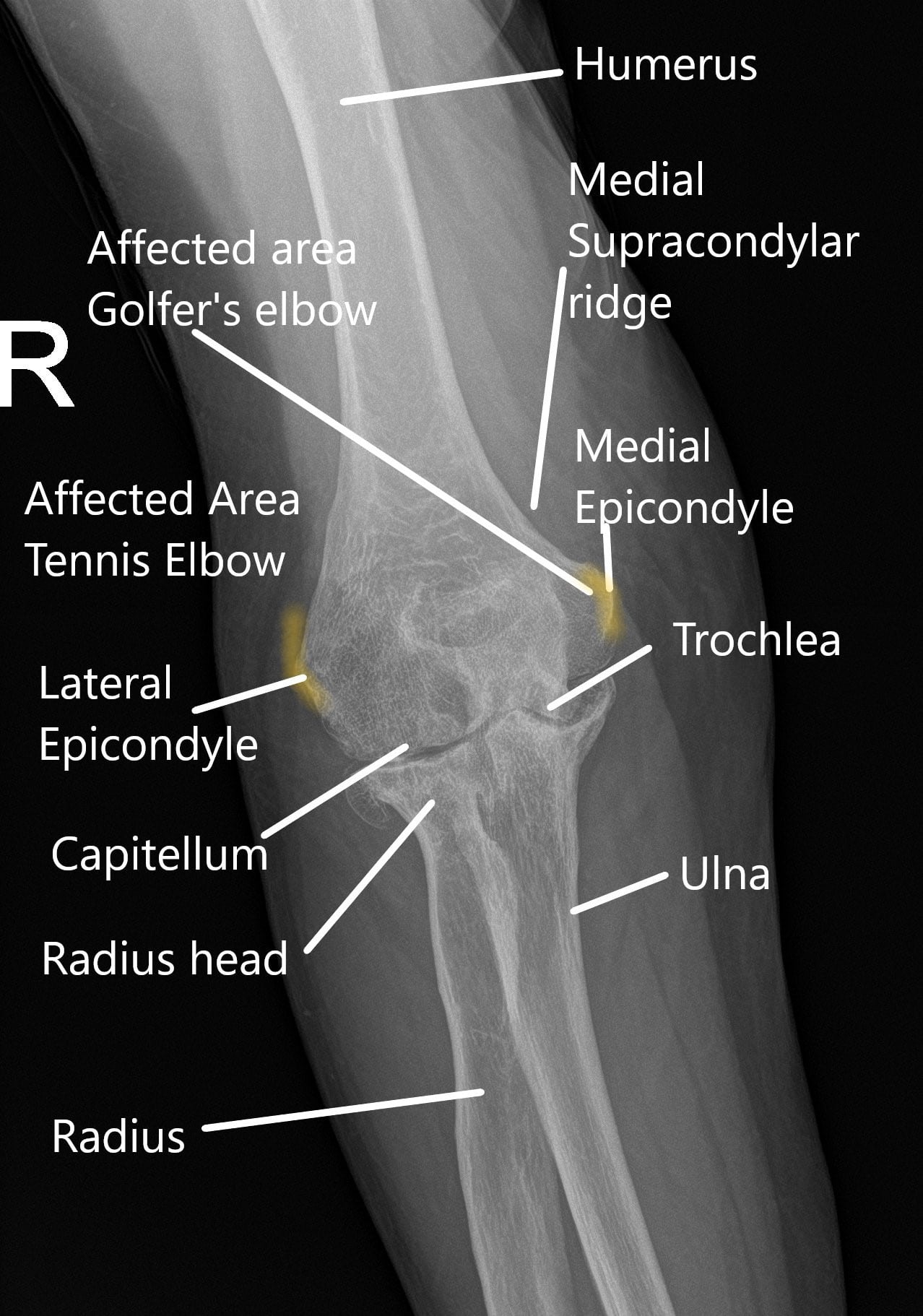Elbow Pain – Causes & Management
Elbow joint is a hinge joint formed used in bending, straightening, and rotating the joint. A number of conditions may cause elbow pain. Elbow pain and swelling may lead to a significant decrease in the function of the upper extremity. Elbow pain affects athletes and nonathletes alike.
The elbow joint is formed by the lower end of the upper arm bone and the two forearm bones. The bones in the joint are held together through tough tissues known as ligaments. Tendons attach the muscles to the bones. The muscles help in the various movements about the joint.
The ends of the humerus, ulna, and the radius forming the joint are covered with articular cartilage. Articular cartilage is a glistening white smooth tissue that aids in the smooth gliding of the joint. There are various bursae lining the joint that reduce friction as various structures cross the elbow.

X-ray of the wrist showing various parts of the elbow joint.
Causes
Elbow pain may have a sudden onset in case of a one-time injury. The injury may be a result of a fall, motor vehicle accident, or violent force over the elbow. The patients usually report severe pain and tenderness to touch. Fractures (broken bone) and dislocation may occur as a result of severe injuries.
Dislocations of the elbow joint may also occur with injury. In adults, the dislocations as usually associated with fractures of the elbow. Toddlers may dislocate their radius bone when swung holding their arms. The condition known as nursemaids elbow can be easily treated in the medical office or ER without surgery.
Injuries incurred during excessive motion of the elbow can be strains or sprains. Strains are small tears in the muscles due to excessive stretching of the muscles. Similarly, when the excessive stretching force acts on the ligaments, it is known as a sprain.
Certain jobs that require excessive rotational force whilst the arm is straight may cause tennis elbow. As the name suggests, the condition affects tennis players due to improper technique. The tendons attached at the outer side of the elbow get inflamed and swollen. Other jobs at risk are plumbers, carpenters, painters, and racquet sports.
Similarly, inflammation of the tendons attached at the inner side of the elbow may cause medial epicondylitis or golfers elbow. Besides golf, other sports involving pitching may also lead to medial epicondylitis. The condition may also affect young growing children known as little leaguers elbow.
Olecranon bursa is located at the back of the elbow. Overuse or constant pressure over the back of the elbow may cause olecranon bursitis. Also known as the student’s elbow, there is inflammation of the bursae. There may be associated swelling of the bursae which may be painful.
Osteoarthritis is a degenerative condition leading to wear and tear of the cartilage forming the joint. The degeneration of the cartilage leads to the grinding of the bones of the elbow causing pain. The condition usually affects older adults but may occur in young adults after fractures of the joint.
Rheumatoid arthritis is a systemic disease affecting multiple joints. The body’s immune system forms cells to destroy own tissues. The elbow joint is affected along with other joints leading to joint pain, swelling, and stiffness.
Osteochondritis dissecans is a condition that affects adolescents. Also known as panners disease, a part of the bone (capitellum) loses blood supply. The condition is more common in the knee joint but may affect elbow as well causing pain.
Nerve entrapments around the elbow joint may lead to elbow pain. The pain is associated with numbness and tingling in the distribution of the nerve. Cubital tunnel syndrome occurs due to entrapment of the ulnar nerve (funny bone) on the inner side of the elbow. Similarly, the radial tunnel syndrome occurs due to entrapment of the radial nerve along the outer side of the elbow.
Diagnosis
The cause of elbow pain is investigated by the attending physician. The physician may take a detailed history of the events leading to pain. History is followed by a detailed physical examination and special tests.
Radiological tests are usually required to diagnose the cause of elbow pain. An X-ray is done to look for bony fractures and arthritis. A CT scan offers a more detailed view compared to an X-ray and is helpful in detecting minor fractures. MRI scan is able to look for the muscles, tendons, ligaments and other tissues normally not visible on an X-ray.
Management
Most causes of elbow pain are non-emergent and usually managed conservatively. Conservative management consists of rest to the part. The patient is advised to stop the activity causing elbow pain. Athletes may require adjustment of the technique usually after a period of rest.
Splints and braces may be used to allow rest to the injured tendon/ligament in the desired position while it heals. Icing the inflamed area provides significant relief in case sprains and strains. Compression bandages help control the swelling of the elbow.
Nonsteroidal anti-inflammatory medications such as ibuprofen and Aleve help reduce swelling and pain of the inflammation. The medications are used carefully in patients with known gastric ulcers and bleeding tendencies. Physical therapy is generally used to increase strength, and improve range of motion.
Surgical management is reserved for patients with no relief from conservative options. The fractures, dislocations, and other traumatic conditions are usually managed surgically. The surgical treatment may require the use of hardware to fix the structures of the joint.
Arthroscopic surgery utilizes a small camera attached to pencil-sized instruments. The camera along with a light source is inserted in the joint to look for causes of elbow pain. The cause can be treated with miniature instruments through buttonhole incisions. The arthroscopic surgery offers the advantage of early recovery and smaller incisions.
Do you have more questions?
Can elbow pain be caused by underlying medical conditions such as rheumatoid arthritis or gout?
Yes, elbow pain can be caused by underlying medical conditions such as rheumatoid arthritis, gout, or osteoarthritis affecting the joint.
How is elbow pain diagnosed?
Elbow pain is diagnosed through a combination of medical history review, physical examination, imaging tests such as X-rays or MRI scans, and sometimes diagnostic injections or nerve conduction studies.
What are the treatment options for elbow pain?
Treatment options for elbow pain may include rest, ice therapy, medications such as nonsteroidal anti-inflammatory drugs (NSAIDs), corticosteroid injections, physical therapy, splinting or bracing, and in severe cases, surgery.
Can elbow pain be managed with conservative measures alone, or is surgery often required?
Many cases of elbow pain can be effectively managed with conservative measures such as rest, activity modification, and physical therapy. Surgery is typically reserved for cases that do not respond to conservative treatment or for severe injuries.
How effective are corticosteroid injections in treating elbow pain?
Corticosteroid injections can provide temporary relief from elbow pain by reducing inflammation and swelling in the joint. However, their long-term efficacy may vary, and repeated injections may carry risks of tissue damage or weakening.
Are there any lifestyle modifications that can help alleviate elbow pain?
Lifestyle modifications such as avoiding repetitive movements or activities that exacerbate elbow pain, maintaining proper ergonomics, and incorporating rest periods during repetitive tasks may help alleviate symptoms.
Can elbow pain affect daily activities and work performance?
Yes, severe elbow pain can interfere with daily activities such as lifting, gripping, and reaching, as well as work-related tasks that require the use of the arms and hands.
What are the risks of delaying treatment for elbow pain?
Delaying treatment for elbow pain can lead to worsening symptoms, progression of underlying conditions, and potential complications such as joint stiffness, loss of function, and chronic pain.
How long does it typically take to recover from elbow pain with appropriate treatment?
Recovery from elbow pain varies depending on the underlying cause, severity of symptoms, and effectiveness of treatment. Some individuals may experience relief within a few weeks, while others may require several months of conservative management or surgical intervention.
Can elbow pain recur after successful treatment?
Yes, elbow pain can recur after successful treatment, particularly if underlying risk factors or causative activities are not addressed. Regular follow-up appointments and adherence to preventive measures may help minimize the risk of recurrence.
Are there any specific exercises or stretches recommended for relieving elbow pain?
Yes, physical therapy exercises and stretches targeting the muscles and tendons around the elbow joint can help improve flexibility, strength, and range of motion, thereby reducing pain and promoting healing.
How can individuals prevent elbow pain during sports or recreational activities?
Preventive measures for elbow pain during sports or recreational activities may include using proper technique, warming up before activity, using appropriate protective gear, and gradually increasing intensity or duration of exercise.
Can elbow pain be a symptom of a more serious underlying condition, such as nerve damage or joint degeneration?
Yes, elbow pain can sometimes be a symptom of a more serious underlying condition such as nerve compression syndromes, joint degeneration, or systemic diseases affecting the musculoskeletal system.
Can certain occupations or activities increase the risk of developing elbow pain?
Yes, occupations or activities that involve repetitive arm motions, forceful gripping, or prolonged elbow extension can increase the risk of developing elbow pain, such as tennis elbow or golfer’s elbow.
How does age and lifestyle factors influence the development of elbow pain?
Age-related changes in joint structure and function, as well as lifestyle factors such as occupation, sports participation, and overall physical activity level, can influence the development and severity of elbow pain.
What are the potential complications of untreated or chronic elbow pain?
Potential complications of untreated or chronic elbow pain may include joint stiffness, muscle weakness, loss of function, decreased quality of life, and psychological distress due to persistent discomfort.
Can elbow pain be a sign of a traumatic injury or fracture?
Yes, elbow pain can be a sign of a traumatic injury such as a fracture, dislocation, or ligament tear, particularly if it is accompanied by swelling, bruising, or difficulty moving the joint.
Are there any dietary or nutritional factors that can impact elbow pain?
While there is limited evidence linking specific dietary factors to elbow pain, maintaining a balanced diet rich in anti-inflammatory foods such as fruits, vegetables, and omega-3 fatty acids may help reduce inflammation and promote joint health.
How does smoking or alcohol consumption affect the risk of developing elbow pain?
Smoking and excessive alcohol consumption have been associated with increased inflammation, impaired tissue healing, and decreased bone density, which may contribute to the development or exacerbation of elbow pain. Quitting smoking and moderating alcohol intake may help reduce the risk of musculoskeletal problems, including elbow pain.

Dr. Suhirad Khokhar
My name is Dr. Suhirad Khokhar, and am an orthopaedic surgeon. I completed my MBBS (Bachelor of Medicine & Bachelor of Surgery) at Govt. Medical College, Patiala, India.
I specialize in musculoskeletal disorders and their management, and have personally approved of and written this content.
My profile page has all of my educational information, work experience, and all the pages on this site that I've contributed to.
